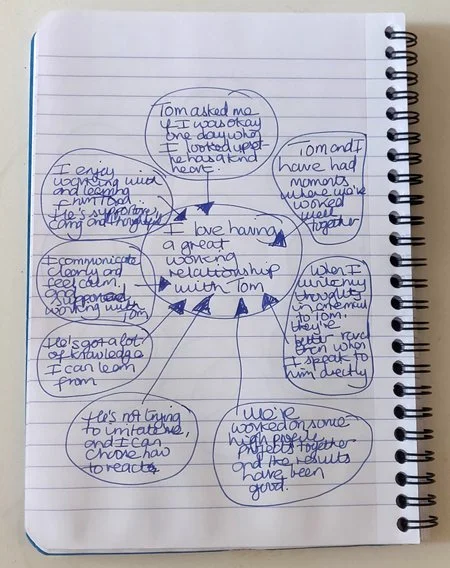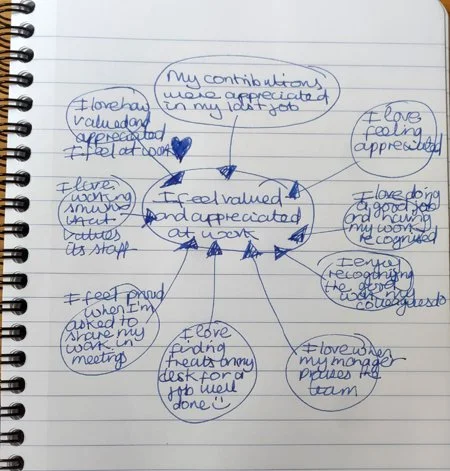The Focus Wheel: a powerful manifestation tool explained step-by-step
🎧 Prefer to listen? Here's the audio version of this post.
If you’re looking for a simple way to shift your mood or perspective, try the Focus Wheel.
It’s a deceptively simple, yet incredibly powerful tool for aligning with how you want to feel. All you need is a pen, paper, and a small amount of time.
I used to mention it often in conversation with my mum and sister. Whenever they were struggling with something, I’d say: “Have you thought of doing a Focus Wheel?”
Apparently, this was annoying (who knew?) But they’re too good a tool to keep to myself.
In this post, I’ll show you exactly how to use a Focus Wheel, with real examples from my own life. By the end, you might be recommending it to your nearest and dearest too.
What is a Focus Wheel and how does it work?
A Focus Wheel is a tool I learned from Abraham-Hicks – an oldie but a goodie.
It helps you shift how you feel about a situation, person, event or anything at all.
You start by writing how you want to feel – your central statement – in a circle in the middle of your page. You then add supporting statements in smaller circles around it. As you go around the circle, you build momentum towards how you want to feel.
Unlike an appreciation or gratitude list, which focuses on what’s already happened, a Focus Wheel lets your imagination run free. It’s a fun process that, depending on the topic, can leave me buzzing with energy and enthusiasm.
Here’s a Focus Wheel I did to improve a working relationship.
How to do a Focus Wheel in 5 steps
Here’s the process in a nutshell:
Write how you want to feel in a circle in the centre of your paper.
Add smaller circles around it for your supporting statements. Start with a supporting statement that’s 100% true and feels good to you.
Add your other supporting statements.
Read back all your statements, drawing arrows to the central statement as you go.
Let’s look at a Focus Wheel example in detail.
Example 1: feeling appreciated at work
Step 1: write your central statement
I had a situation where I felt frustrated that my boss didn’t seem to notice my hard work. In the middle of my Focus Wheel, I wrote how I wanted to feel:
‘I feel valued and appreciated at work.’
Notice I didn’t write I want to feel valued… but I feel valued….
Writing that you feel a particular way when you don’t, might feel uncomfortable at first. This is because your rational mind pipes up: ‘But I don’t feel that way!’ Don’t get caught up in this. Just reassure yourself you’re simply imagining how it would feel.
Step 2: choose your first supporting statement
Your first statement needs to be true, believable, and feel good. This stabilises your Wheel so you don’t get ‘thrown off into the bushes’ (as Abraham-Hicks would say).
I wrote down:
‘My contributions were appreciated in my last job.’
This was true and felt good to remember, giving me a solid footing.
Step 3: add remaining supporting statements
‘Try on’ your supporting statements first, and see how they feel. If they feel meh, find ones that feel better.
Here’s what I added:
I love feeling appreciated
I love doing a good job and having my work recognised
I enjoy recognising the good work my colleagues do
I love when my manager praises the team
I love finding treats on my desk for a job well done
I feel proud when I’m asked to share my work in meetings
I love working somewhere that values its staff
I love how appreciated and valued I feel at work
You can add as many statements as you like.
Some statements I drew from real memories, and others came from my imagination.
A boss has never left treats on my desk for a job well done. But the thought popped into my mind and delighted me. So it went on my Focus Wheel.
You can write outside the circles!
Step 4: read back your statements and anchor the feeling
Once finished, I read each statement out loud and draw an arrow to the central statement.
When I get to the end of a Focus Wheel I sometimes feel so excited and loved-up that I’m not sure what to do with my energy.
Nothing yet has changed externally, but I feel the way I want to feel, and that’s the point.
Example 2: healing a friendship
Here’s a quick example of how I used a Focus Wheel to help heal a friendship.
I once had an argument with a long-time friend after she kept talking over me during a sensitive conversation. We left the restaurant without saying goodbye to each other, and I went home feeling frustrated and hurt.
The following morning, I decided to do a Focus Wheel. My central statement was:
‘I love how heard and seen I feel when I talk to Claire.’
My first supporting statement was:
‘Claire and I supported each other during lockdown.’
I built up my Wheel with more positive statements and good feeling imagined outcomes. My vibration shifted and later Claire and I exchanged voice notes about what had happened. Our friendship healed, and in one way deepened because of our honesty.
Will Claire ever listen to me with full presence, compassion, and without interrupting? Maybe, maybe not. But by doing the Focus Wheel I acknowledged the part of me that wanted that, and I embodied the feeling of having it. I knew I’d see it reflected back to me, if not by Claire, then by another, or others.
This is the power of a Focus Wheel: you change your inner state, and your outer world forms around it.
4 tips to get the most out of your Focus Wheel
Notice body cues. If you feel any tightness in your body, look at the statement you’ve just written. If it feels off, change it. You may need to harmonise with the statement, so feel where the tightness sits in your body and breath into it until it dissipates.
Embrace repetition. Some statements may seem repetitive, but this helps to anchor within you the feeling you want to embody.
Start with truth, build with imagination. The statements in the first half of my Focus Wheels tend to be truth-based. This helps me get a firm, solid footing on the Wheel. The second half is where my imagination comes into play. This combination builds energy and momentum.
It’s not always a one-and-done. Some topics have layers to work through. Each Focus Wheel will help raise your vibration, but you might need to do a few to fully embody the feeling state you want. You can do them back-to-back if you’re on a roll, or space them out.
What to do when a Focus Wheel doesn’t work
Sometimes I’ll do a Focus Wheel and, at the end, feel no shift in my feeling state.
Usually, it’s because I’m too entangled and bogged down in the vibration of what I don’t want.
If this happens, don’t force it. You haven’t done anything wrong and you haven’t failed.
Ask yourself: ‘What would feel good right now?’ Maybe it’s a walk, a movie, or cooking some nice food. You can always do another Focus Wheel at a later time.
Final thoughts: choose to feel good
You don’t have to stay in a crappy-feeling, low vibration. The Focus Wheel gives you a simple, yet powerful way to move up the emotional scale.
What’s one area of your life that could benefit from the transformative power of a Focus Wheel?
Grab your pen and paper, or download my free printable template below and give it a try.


